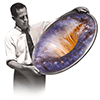This is Chapter 10 from The Man Who Mastered Gravity, now available from Amazon and fine booksellers everywhere.
(1924)
When Denison University opened its new Swazey Observatory in 1911, Professor of Astronomy Dr. Paul Alfred Biefeld was named its Director.
Biefeld earned his B.S. in electrical engineering at the University of Wisconsin in 1894, after which – like Robert Millikan – he pursued graduate studies in Europe. He earned his Ph.D from the Zurich Polytechnic Institute in 1900. When Biefeld’s name finds its way into publication, he is often dubiously described as a colleague or classmate of Albert Einstein, though it is unlikely that the two had anything more than the passing acquaintance of students attending a large university at roughly the same time. The only thing that Einstein and Biefeld really had in common was music. They both played the violin.
Einstein failed his first entrance examination for the Zurich Polytechnic Institute in 1894, was finally admitted in 1896, and graduated as a secondary school teacher of mathematics and physics in 1900 – the year that Biefeld earned his doctorate. Biefeld remained at Zurich Polytechnic for six years, while Einstein left academia and found work as a clerk at the patent office in Berne, Switzerland. Despite scant evidence that the two actually knew each other, 74-year-old Dr. Biefeld told a newspaper in 1941 that “when Einstein would forget to go to a class, he would come and borrow my notes to get caught up on what he had missed. He was rather careless in his appearance, and made no show of himself. Yet he had strong ideas and wasn’t afraid to speak them out.”
In 1924, Cal Tech dropout Townsend Brown showed up at Denison University chastened by his experience in Pasadena and determined to devise the sort of practical invention that would demonstrate a link between electricity and gravity. He found a sympathetic ear in Dr. Paul Biefeld:
Dr. Biefeld had been interested in the subject of gravitation for many years. This interest probably coincided with Einstein’s interest in the Unified Field Theory and in the new concept of Relativity which was gaining recognition at that time. Biefeld believed in the possibility of some connection with gravitation. As he expressed it, “I am constantly on the look-out for something that might represent an ‘electrodynamic-gravitational’ coupling.”
A pivotal exchange took place when Brown asked Biefeld, “If a coupling did exist, what instrument might it resemble?” Biefeld thought for a few minutes and then answered without equivocation, “the capacitor.”
A capacitor stores and discharges electrical energy. It typically consists of two charged metal plates – the electrodes – that are separated by an insulating substance called a dielectric, which cause the electrodes to absorb their charge without actually conducting it between them. A typical electrical circuit has anywhere from one to hundreds of capacitors, each capable storing a different level of charge and discharging that charge according to the requirements of the circuit.
In this telling of the tale, Brown suggests that it was Biefeld who first suggested that the mechanism for the transmission of gravitation might resemble the common capacitor. But Brown had already observed the effect in his Coolidge X-ray tube, which, with it’s asymmetrical electrodes, actually acted as precisely the kind of capacitor Biefeld was supposedly proposing.
In 1977 Townsend Brown wrote in his brief memoir,
1The basic Biefeld-Brown effect is quite simple. It is manifested as a departure from the Coulomb Law of electrostatic attraction, in that the opposite forces are not equal. The negative electrode appears to chase the positive electrode so that there is a net force of the system… in the negative-to-positive direction.
By “departure from Coulomb Law,” Brown is referring to the electrical theory that opposite charges attract and like charges repel, as first articulated in 1785 by the French physicist Charles Augustin de Coulomb2. Under normal circumstances, oppositely charged particles or surfaces of equal mass would attract each other equally. But the behavior Brown observed in his Coolidge tube – where the negative charge is slightly greater than the positive charge – the negatively charged surface is drawn toward the positive. Or as Brown put it, “the negative electrode appears to chase the positive electrode.”
There is not much more in the record about the relationship between Paul Biefeld and Townsend Brown, or how the Biefeld-Brown effect came to be so named. What seems likely is that after his unpleasant experience at Cal-Tech, Townsend Brown sought cover for his ideas – by attaching a credentialed elder’s name to a discovery that could just as easily have been named wholly for himself. Calling his own discovery ‘Biefeld-Brown’ may be the first example of a practice that would recur throughout his life: hiding in plain sight.
1 Towsend Brown Autobiography (from Family Archives)
